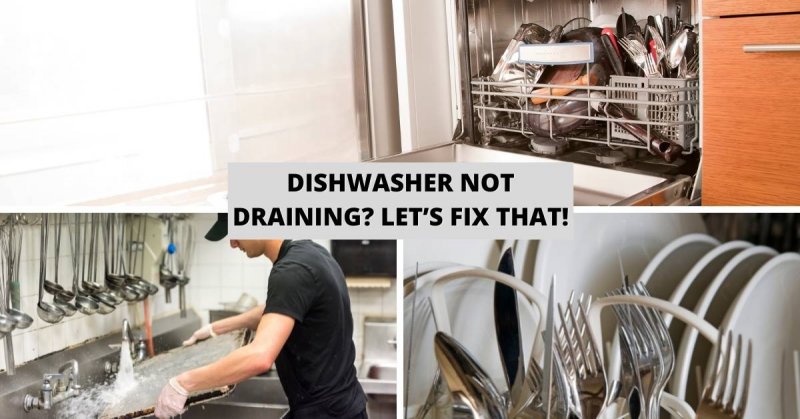Dishwashers are marvellous inventions that make doing the dishes, one of the most repetitive of domestic chores easier for us to do. It can be annoying when something does not work the way you expect. This can be true for any device or machine that you or your family frequently use at home.
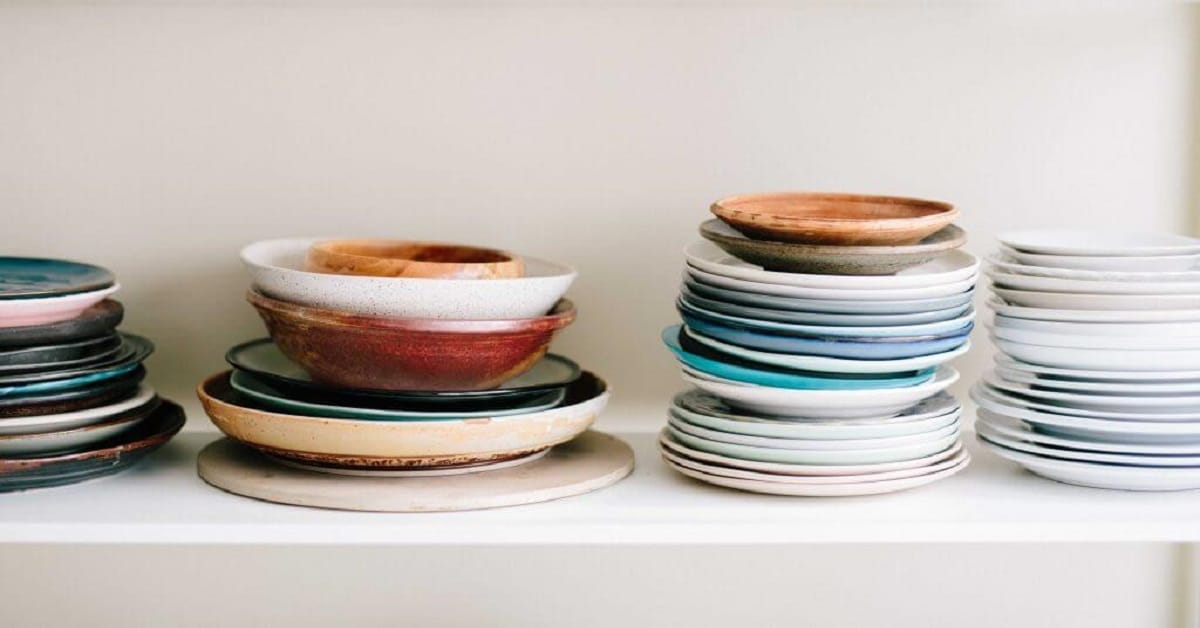
There could be a few reasons why the water in your dishwasher is not draining as it should, but you do not have to worry, just continue reading to find out all the possible causes and its corresponding solution.
Thank you for reading this post, don't forget to the best blogger Guy About Home who offers the best garden and home improvement tips! If you are a home decor and design fan, don't miss the tips on home ideas. If you are a home garden owner, then you might be interest in our complete guides to house plants!
Don’t dial the number of your local plumber just yet, read through the methods below and follow the instructions step by step.
How to fix a clogged dishwasher
First and Foremost, Check the Plumbing
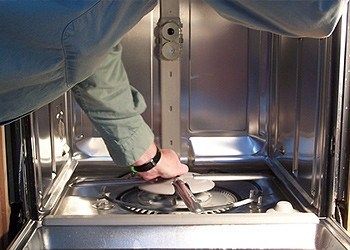
Image Source: Pinterest
Your dishwasher has a drain hose which is connected to your kitchen sinks drain and garbage disposal unit. If your kitchen sink is clogged or slow to drain, this, in turn, will cause your dishwasher not drain correctly as well.
Turn on your garbage disposal and run hot water from your kitchen sink to flush anything that may have gotten lodged in the garbage disposal.
If that does not get rid of the clog in your sink, then follow these methods on how to fix a slow drain and have that done in a jiffy.
Be sure to check the air gap; it is the metal cylinder normally located beside your kitchen sink. If water is coming out of the air gap, then the obstruction is located inside the pipe that connects the air gap to the garbage disposal. You should be able to fix that by using a drain snake.
If you have a newly installed garbage disposal unit, be sure to pop out the drain plug. That can also be another reason your dishwasher is not draining correctly. If your not sure where the drain plug is then watched this video for an in-depth guide .
Check the Interior parts of the Dishwasher
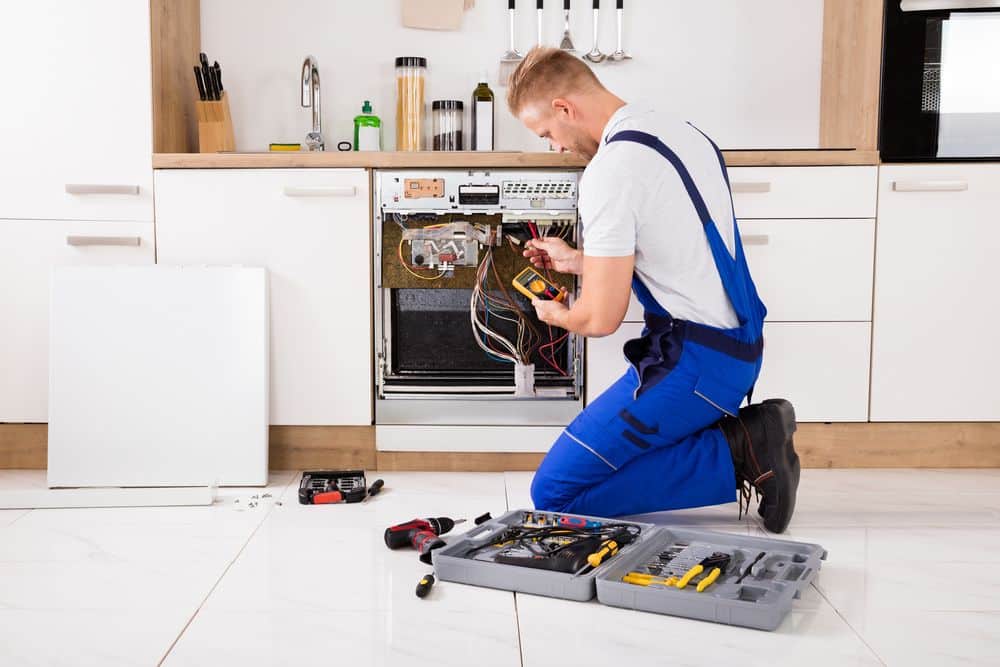
Image Source: Pinterest
Before you begin checking on the internal parts of your dishwasher, it would be best to locate your owner’s manual if you still have it. In case you do not, you can quickly go to your manufacturer’s website and download an official copy.
Do these steps first before going through the trouble of moving your dishwasher cabinet from its rightful place along your kitchen counter, try to check on a few things internal components first.
Step 1 – First, you need to make sure your dishwasher disconnected from its power source, unplug it from the wall socket and shut off the circuit breaker it is connected to as well. Be sure to turn off the water line that is connected to the dishwasher as well; this usually is a flexible, braided metal hose.
Step 2 – Instead of removing the dishes individually, remove the entire bottom dish rack and set it aside on top of your kitchen counter. Clean the tray if necessary.
For the water that did not drain, remove it with a cup, bottle or any container and empty it into a bucket. You can use old towels or extra absorbent wash cloths to dry wash tub and absorb the remaining water.
Step 3 – Check the drain, you should be able to unscrew the drain by hand or if you need to, use a screwdriver. Wash the drain strainer, clean the actual drain and remove any debris that may be present.
Step 4 – Remove and clean the filter; most modern dishwashers have cylindrical filters located beneath the bottom spray arm. You usually do not need to remove the spray arm to get at the filter, in case you do, turn the centre nut counter-clockwise till it comes off then lift the spray arm out of the wash tub.
Once you see the circular shape of the top of the filter, turn that counter-clockwise until it is loose then lift it up and out of its housing. Some filters are located at the back of the dishwasher, that is why you need double check your owner’s manual for the location of its parts.
Clean the filter by using a sponge, hot water and dishwashing liquid soap, be sure to remove any and all type of debris like grime and chunks of old food.
Next, clean the housing of the filter, when you removed it from inside the dishwasher it would have left this big circular hole, reach in and scoop up any gunk, bones, etc. that may be inside. Wash and rinse the sump out for good measure.
Once you are satisfied the filter is clean, reinstall it correctly along with any parts that you may have removed. Run the dishwasher to see if that fixed the dishwasher not draining problem.
Be sure to check the door latch as well sometimes an unlatched door can cause it not to drain.
If the problem persists and the dishwasher won’t drain, proceed with more troubleshooting.
Dishwasher still won’t drain
Check the Drain Hose
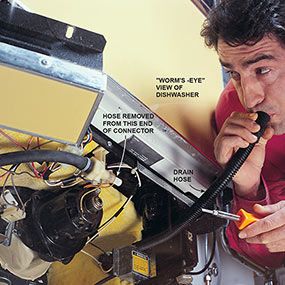
Image Source: Pinterest
This is how your dishwasher gets rid of all the water it consumes after completing a cleaning cycle. The dishwasher’s water pump uses pressure to push the water out of the wash tub and into the plastic drain hose which is typically connected to your kitchen’s disposal or drain.
Step 1 – Then you need to move your entire dishwasher forward and out of its original position, just enough so you can access the back.
To access the drain hose, you need to remove the kick plate which is also sometimes called the toe plate and is located under the dishwasher door.
In case you are wondering, the purpose of the toe plate is to protect your toes and feet from getting stuck under the dishwasher.
Step 2 – Scan the bottom sides of your dishwasher, and you should see a couple of screws holding the toe plat in place. Use a screwdriver and turn counter clockwise to remove all the necessary the screws, set them aside. Then grab hold of the toe plate and gently lift it up to dislodge and remove it from the bottom. Follow the drain hose and remove any kinks that you can see.
Step 3 – If needed, you can quickly remove the drain hose by loosening the hose clamp to the dishwasher pump. Have a pan ready to catch any water that may spill on the floor and a clean wash cloth to wipe the end of the hose.
Then on end you just cleaned and detached from the dishwasher, lift it up to your mouth and blow hard. If you were unable to blow air through the hose, then it is clogged, and you would need to loosen the clamp on the other end to be able to clean the hose.
Step 4 – Try using a high powered hose to clean the inside of the drain hose or a snake drain can also remove any blockage inside the drain hose. If the drain hose is too damaged and needs to be replaced, do that to fix your dishwasher not draining problem. Once done, just work backwards and reattach everything to its proper place.
Check the Drain Valve
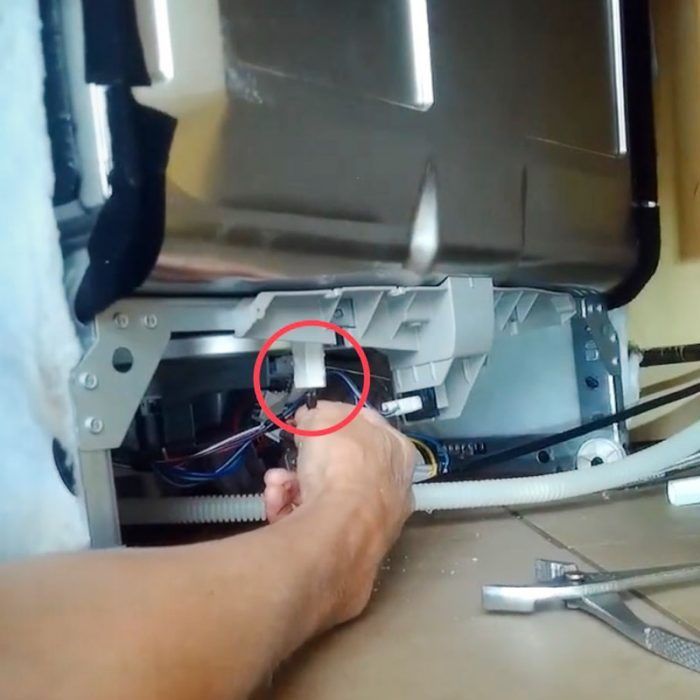
Image Source: Pinterest
Allow the dishwasher to cool before checking in this part to avoid unnecessary injury. It is possible that the drain valve malfunctioned and got stuck shut causing your dishwasher not to drain.
You can find the drain valve under the dishwasher, behind the toe panel. You would need to remove the toe\kick panel to gain access to the drain valve. It is generally located beside the motor, again check your owner’s manual for its precise location.
The main purpose of the drain valve is to make sure water does not drain back into the dishwasher. Not all dishwashers have this, check your owner’s manual to verify.
If you’re not sure how to check the drain valve, you would need to first check if you have valve bracket and this should move freely to verify that it is working.
After doing everything you can and you’re still won’t drain, call the manufacturer and schedule a service call. It might be free if it is still under warranty. You can also call your local plumber, but again be sure to hire a licensed, insured plumber to avoid any undue stress.
Conclusion:
Don’t be in a hurry to spend your hard earned money on a professional that may just do one of the methods indicated above to get your dishwasher to drain correctly again. Try doing it yourself; once you have done some basic troubleshooting and was not able to resolve the problem yourself, then you know that at least you tried and now your calling for backup.
For more amazing ideas you can have, visit Guy About Home today or you can check the related blogs:


